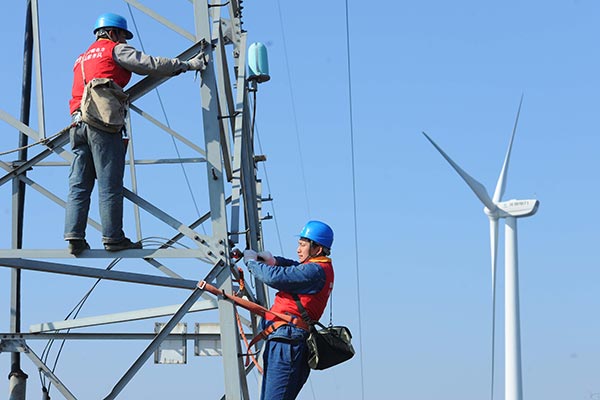Make wind power pledges more than hot air
By Gao Jin'an (China Daily) Updated: 2016-04-13 08:09 |
|
Workers with the power supply company in Chuzhou, Anhui province, check the transmission network under the State Grid before it is connected with a local wind power farm. SONG WEIXING / FOR CHINA DAILY |
From excitement to a sort of disappointment, this all happened to me in a matter of just two weeks.
On March 16, the annual session of the country's top legislature concluded in Beijing, with the 13th Five-Year Plan (2016-20) being endorsed. A section of this ambitious plan focuses on energy upgrading, vowing to increase the share of renewable energy in total consumption, including wind power.
It seemed to me that with an expected reduction in coal use, which now stands at 64 percent of the total, we might see fewer smoggy days and the bright and clear days would soon be on the horizon.
However, at the very end of that month, March 31, a piece of bad news came as a shock, somehow dashing my hopes for fresh air and blue sky.
Qin Haiyan, secretary-general of the wind power committee of the Chinese Renewable Energy Society, said about 15 percent of wind power in the country was wasted in 2015 because a chunk of electricity from wind farms, built with billions of yuan in investment, could not be supplied to the power grid system due to restrictions imposed by some local authorities. The amount was about 33.9 billion kilowatt-hours, translating into direct losses of more than 18 billion yuan ($2.78 billion).
At some wind farms in Gansu and Heilongjiang provinces and the Ningxia Hui autonomous region where wind power resources are abundant, as much as 60 percent of electricity generated was abandoned.
A calculation showed that from 2010 to 2015, electricity generated by wind farms but abandoned amounted to about 100 billion k/h, equivalent to the combined 2015 amount of power generated by the Three Gorges and the Gezhouba hydropower plants on the Yangtze River, two of the largest hydroelectric projects in China and the world.
Why so, when the country has embarked on the road of green development?
At the Paris convention on climate change in December 2015, China announced plans to bring its share of non-fossil energy in its total energy consumption to about 20 percent by 2030. The new five-year plan also vows to promote, among other clean and renewable energies, the development of wind power.
But the road to this goal is not easy.
At the end of last year, wind power accounted for merely 3 percent of the country's electricity generation capacity. According to Qin's estimates, to meet the renewable energy goal, China needs to have at least another 250 million kilowatts of wind power capacity installed by then, and the installed capacity at the end of 2015 was 128 million kilowatts. The National Energy Administration has planned the construction of an additional 30.83 million kilowatts of wind power capacity this year.
However, some local governments, for regional or short-termed benefits such as nicer looking GDP figures and employment statistics, still preferred coal-fired power plants and restricted the access of wind power to the grids, hurting not only the wind farms, but also enthusiasm in wind power investment and development of the wind power industrial chain.
As early as in 2006, China adopted the Law on Renewable Energy, which mandates the role of new energy in green development and offers a legal framework for access of wind power to the national grid systems. That seems to remain as pledges on paper.
In some regions, the law and national policies on renewable energy are not well enforced, thus creating hurdles for the development of the new-energy sector. The road to green development, however, not only calls for the removal of such obstacles, but also good coordination among all regions.
The wind power committee of the Chinese Renewable Energy Society has decided to take administrative or even legal action against some local governments in order to clear the hurdles for wind power industry growth. Let's hope such action would work wonders.
To build a better environment and follow the road of green development, I'd like to borrow a line of the lyrics of Bob Dylan's song, the answer is blowing in the wind, or at least, part of the solution.
- China leads as green energy investment plans hit record high
- Wind power puffs up company's future via State strategy
- China's new wind power capacity rises 60%, hits record high
- Combined coal, wind power grid approved for national pilot program
- China to cut on-grid tariffs for solar, wind power: State planner
- Make wind power pledges more than hot air
- Audi sales in China grow markedly in Q1
- China's water sports industry buoyed by affordable luxury
- Blackmores downplays tax change on online goods
- CRRC seeks more US rail deals after landing Chicago order
- JD Finance comes to the rescue of startups
- China's FDI rises 4.5% in Q1
- World Bank projects China's economy to grow 6.7% this year

















